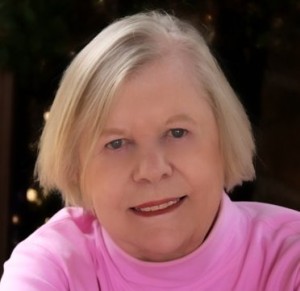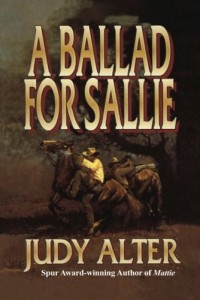 Relevant History welcomes Judy Alter, who writes the Kelly O’Connell and the Blue Plate Café mystery series—but for many years she wrote historical fiction and nonfiction for adults and children, mostly about women in the American West. She is the winner of two Spur Awards from Western Writers of America, two Western Heritage (Wrangler) Awards from the National Cowboy Museum and Hall of Fame, and the Owen Wister Award for Lifetime Achievement from WWA, among other honors. These days Judy’s western works are categorized as western historical romance although that wasn’t her intent when she wrote them. For more information, check her blog, and look for her on Facebook, Twitter, and Goodreads.
Relevant History welcomes Judy Alter, who writes the Kelly O’Connell and the Blue Plate Café mystery series—but for many years she wrote historical fiction and nonfiction for adults and children, mostly about women in the American West. She is the winner of two Spur Awards from Western Writers of America, two Western Heritage (Wrangler) Awards from the National Cowboy Museum and Hall of Fame, and the Owen Wister Award for Lifetime Achievement from WWA, among other honors. These days Judy’s western works are categorized as western historical romance although that wasn’t her intent when she wrote them. For more information, check her blog, and look for her on Facebook, Twitter, and Goodreads.
*****
My career as a western writer began with a chapter in an anthology. When the women of Western Writers of American decided to put together an anthology about women who won the West, I volunteered to write about Georgia Arbuckle Fix, a pioneer woman physician on the prairies of western Nebraska.
Her life as a doctor was filled with adventure—she had to learn to “read” the prairie so she wouldn’t get lost in those vast open spaces. Once she was called to repair a hole in a young man’s skull—he had been hit by the spinning handle of a water bucket rope. Dr. Fix sewed a flattened half dollar over the hole, and that man was still riding in the rodeo parade when he was seventy-five. Another time she was called to a birth in a filthy house with five raggedy, hungry children and the father gone off somewhere. During the two days she spent cleaning the house and children, she found the father’s stash of liquor and poured it on the ground. Rumor is that nothing would ever grow in that spot.
All of this was fact, supported by articles about Dr. Fix in reputable sources, but it was great fodder for historical fiction. And I eventually turned it into a novel called Mattie, blissfully unaware that Mari Sandoz had written the same story in Miss Morissa. My career writing about women of the West was launched.
It was easy to avoid the western myth in that book because I had facts—and no cowboys and Indians. But in the mid-to-late nineteenth century, the western myth was born and fostered by such artists as Frederic Remington and Charles M. Russell and novelists like Owen Wister, author of The Virginian, who created the image of the silent, strong, flawless cowboy, the eastern schoolteacher come West, the shootout, the uncivilized Indian, and other stereotypes. Eastern publications such as Leslie’s Illustrated, Harper’s Weekly, and Harper’s Monthly strengthened those stereotypes, and easterners saw an American Wild West that never existed. Eventually, in the early twentieth century, that mythic West showed up on movie screens.
 For the novelist writing about the American West, separating fact from myth may be the greatest challenge. Writing about the realistic West requires research and the ability to resist the West of novels, paintings, and movies. I often found it both fascinating and more accurate to fictionalize the life of a real woman, and thus I wrote about Libby Custer, Jessie Benton Frémont, Etta Place of the Hole in the Wall Gang, and a cowgirl named Lucille Mulhall, though she became Cherokee Rose in my book.
For the novelist writing about the American West, separating fact from myth may be the greatest challenge. Writing about the realistic West requires research and the ability to resist the West of novels, paintings, and movies. I often found it both fascinating and more accurate to fictionalize the life of a real woman, and thus I wrote about Libby Custer, Jessie Benton Frémont, Etta Place of the Hole in the Wall Gang, and a cowgirl named Lucille Mulhall, though she became Cherokee Rose in my book.
 The real lives of some women of the West were so fascinating they didn’t need the embellishment of the myth. Did you know, for instance, that General Custer delighted in quirting his wife’s horse until it bolted and ran off across the prairie with her clinging to its back? Or that Lucille Mulhall could rope multiple horses with one loop? Or that Etta Place rode on robberies with the gang, riding hard for days in the getaway?
The real lives of some women of the West were so fascinating they didn’t need the embellishment of the myth. Did you know, for instance, that General Custer delighted in quirting his wife’s horse until it bolted and ran off across the prairie with her clinging to its back? Or that Lucille Mulhall could rope multiple horses with one loop? Or that Etta Place rode on robberies with the gang, riding hard for days in the getaway?
For most women of the American West, in that time period life was hard, with physical labor from dawn to night—tending children, making a home in a sod hut, cooking over a fire fueled by prairie chips (buffalo droppings) and collecting those chips in a wheelbarrow. Their complexions were ruined by sun and wind, they lost too many children in infancy and youth, and they themselves died young. That is not the stuff of storytelling.
But there were and still are fascinating stories of women who lived with optimism and a certain freedom from restraint that their eastern sisters didn’t enjoy. Their stories should be told in fiction. Novelists need to explore the real women of the historical West or create their own characters who take advantage of the opportunities of the new land.
As recently as the early twenty-first century, publishers didn’t get the idea. Covers resorted to the mythic West—for instance, the original cover of Libbie shows her standing in a field of prairie grass beside a barbed wire fence—barbed wire had barely been introduced by the time Custer was killed. In the background was a stockade—when the text made clear forts were not fenced, let alone with sturdy logs in the treeless West. The cover of Sundance, Butch, and Me shows men robbing a train—nary a woman in sight. And the cover of Ballad for Sallie, a novel about a street orphan in Fort Worth, shows a man dismounting a horse while his gun blazes away.
Unfortunately the myth lives on. Only accurate research will counter its effects.
*****
 A big thanks to Judy Alter. She’ll give away trade paperback copies of Ballad for Sallie to two people who contribute a comment on my blog this week. I’ll choose the winner from among those who comment by Friday at 6 p.m. ET. Delivery is available within the continental United States only.
A big thanks to Judy Alter. She’ll give away trade paperback copies of Ballad for Sallie to two people who contribute a comment on my blog this week. I’ll choose the winner from among those who comment by Friday at 6 p.m. ET. Delivery is available within the continental United States only.
**********
Did you like what you read? Learn about downloads, discounts, and special offers from Relevant History authors and Suzanne Adair. Subscribe to Suzanne’s free newsletter.

Welcome to my blog, Judy.
Wow, Custer sure had it coming, didn’t he?
Not what Libbie thought. She spent 35 years of widowhood making him a martyr/hero. Today, the tide has changed.
Sounds like Libbie was a “woman who loved too much.”
Sounds like doctors in those days were like carpenters: use whatever comes to hand to fix the problem in front of you. I must read your Mattie, it sounds fascinating. Thanks for a great article!
What really happened is usually so much more interesting than the myth anyway! Glad to see you’re writing that.
I have always admired the women who had the courage to trek off into the far reaches of our young country. Thanks so much for this glorious look at the reality.
Yes, Anna, doctors used whatever came to hand–like pliers for pulling teeth. I admire the women who went west too, Terrie, and by no means all of them meekly followed adventuresome husbands. An amazing number of single women homesteaded and made other lives for themselves in the West. You’re right, Sandra, reality is much more interesting than the myth.
How ironic. Through fiction you were able to highlight reality over myth!
Pam, I suspect fiction should always do that, but fiction was a big contributor to the myth of the Wild West.